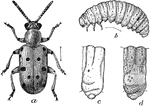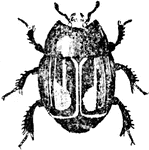Clipart tagged: ‘elytra’

Crioceris 12-Punctata
"The mature beetle in life rivals asparagi in beauty, but may be distinguished by its much broader elytra…

Mimic Beetle
"The Mimic Beetles seldom exceed one-third of an inch in length, and are of very solid consistence,…

Brachelytra
"Readily distinguished from the other groups of beetles by having the elytra much shorter then the abdomen,…